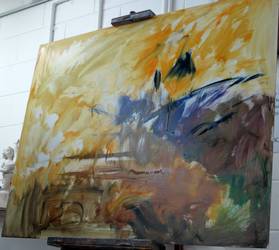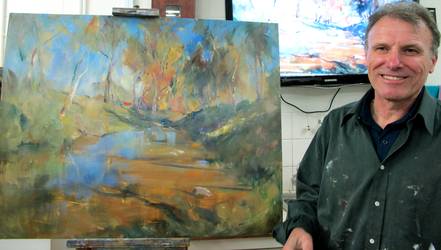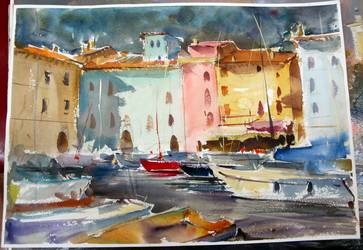Angelo Quabba demonstration 17th August 2013
Oils – Landscape
Angelo was a very humorous, lively oil painter with an Italian accent. He was quite talkative, sometimes asking rhetorical questions of himself about decisions to be made in the progress of this painting. The subject was a creek in the Beechworth bush. He has spent much time in Northern Victoria since coming from Italy when he was 30. He loves nature with a passion. If you search the internet for his works you will see that they are lively, colourful and extremely varied in subject.
Today he set up an mdf board which had two coats of gesso primer. He was not terribly happy with it. He often said that he should have brought a canvas. “This board is very thirsty”, he said. It soaked up the paint to the extent that he had to add medium to get it to cover. After a rough loose sketch with a brush, no careful pencil drawing, he set about losing the white space energetically with vigorous scrubbing brush strokes. The brush was just a cheap one inch flat. He also used a filbert and a rigger at different times. And a palette knife. Care of the brushes was important. After washing them put weights on the bristles to stop them splaying out.
His brush movement was broad and fast, no slow deliberate close work. Standing back from the work he flicked away at full arm’s length, telling us of a famous artist, Joachim Sorolla, who used metre long brushes.

The board completely covered
Once the board was covered with paint strokes which only loosely suggested the scene in the photo he rubbed it back a bit so that later colours would be cleaner and brighter. He advised not to put fine detail in too early. He was conscious of perspective and distance. To suggest distance your further back colours should not be as bright as those in the foreground. Having done the water he began erecting verticals using the rigger to make the tree trunks. Some of them were reflected in the water but not too many as you lose the effect. Often he ‘painted against the form’, i.e. the marks went across the trunk rather than down it. He was quite emotional and intuitive about his work, often asking himself questions about whether he liked this or that. He used a mirror to get a second view of the picture. If he wasn’t happy with an area he would rub it back and start again.

When asked about his influences he quoted John Singer Sargent, E Phillips Fox, Giovanni Boldini, Arthur Streeton and Charles Condor. You can learn a lot from them, particularly if you compare their early and later work to see what they were trying out. It was a very popular demonstration, going a bit over time as the audience were very attentive and appreciated his work.
Angelo with the finished work
Angelo brought several unframed paintings like these below and a folio of his drawings - he emphasized the importance of drawing.


Colin Browne, WAA Secretary